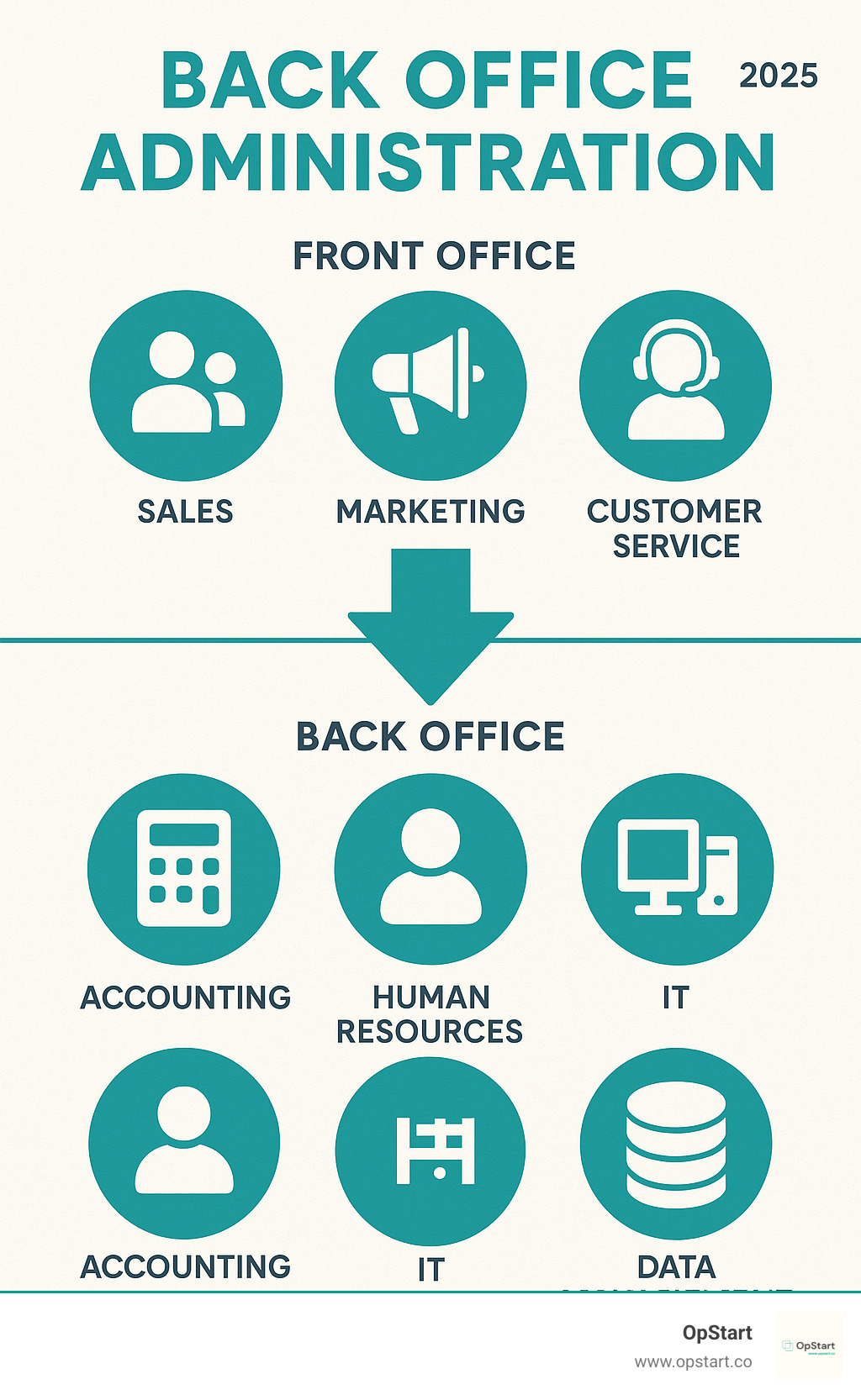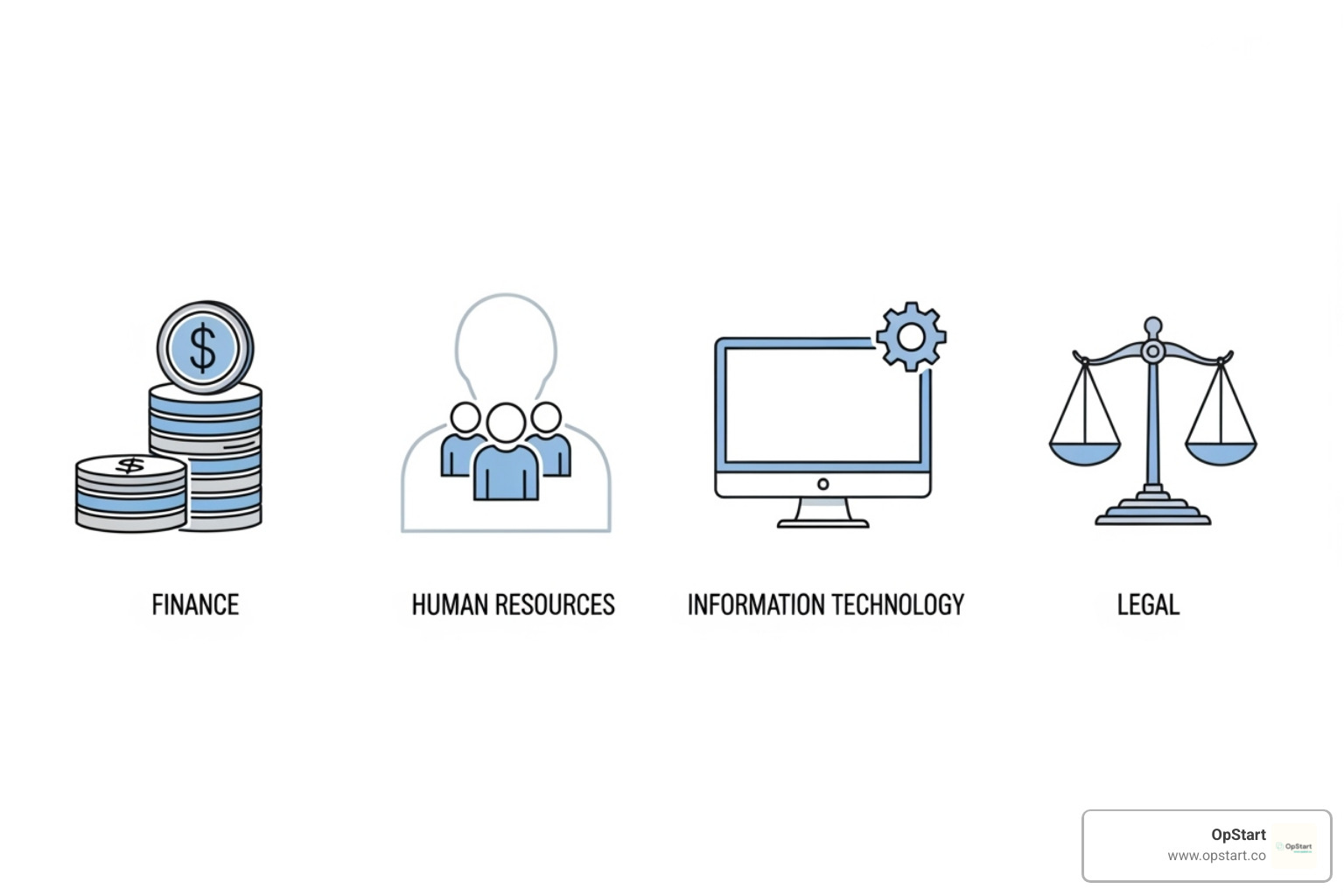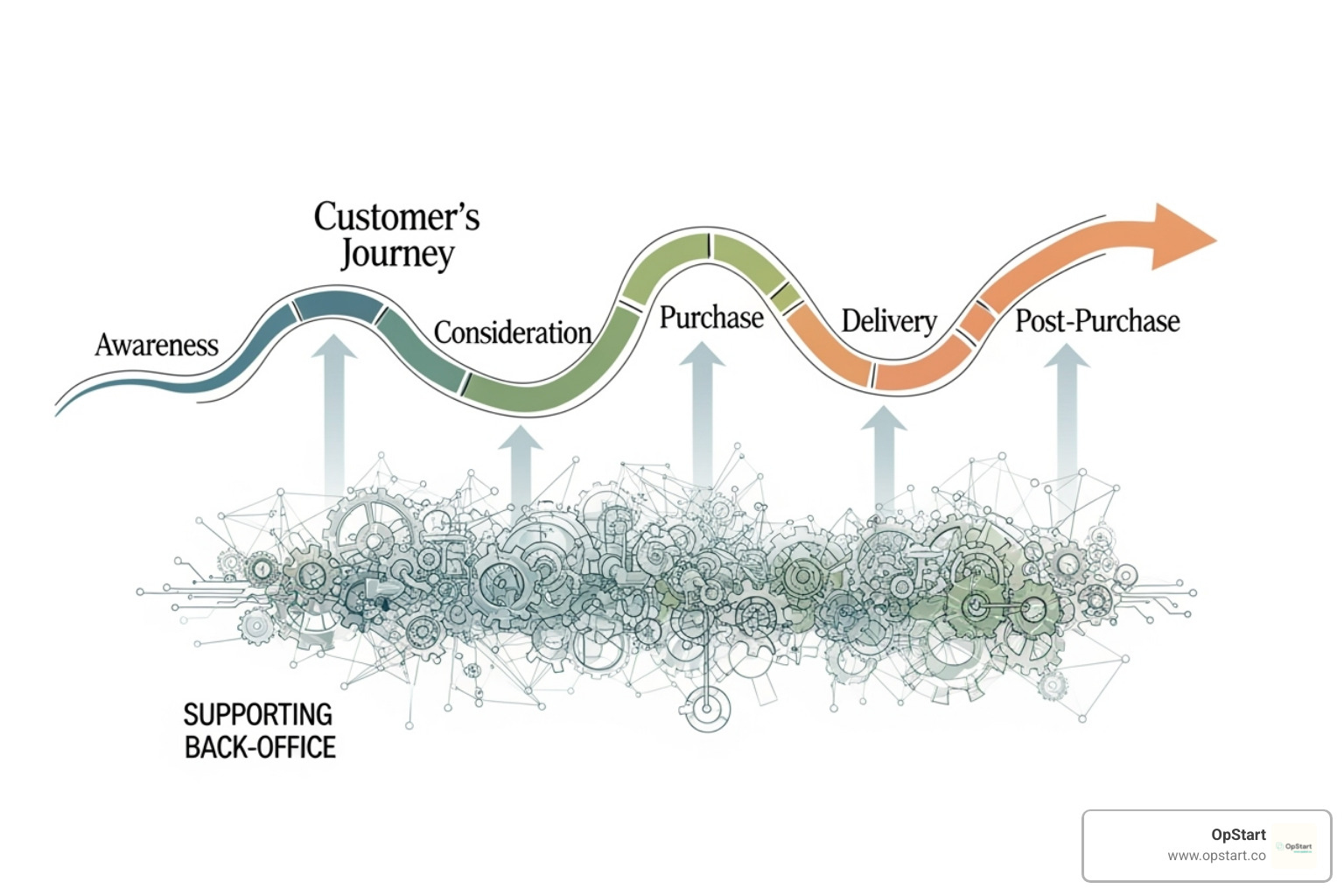Why Back Office Administration Powers Your Business Success
Back office administration is the engine room that keeps your business running smoothly. These are the behind-the-scenes operations that handle everything from accounting and payroll to data management and compliance – all the critical tasks that don’t involve direct customer interaction but make customer-facing work possible.
Key Components of Back Office Administration:
- Accounting & Finance – Managing transactions, budgets, and financial reporting
- Human Resources – Handling recruitment, payroll, and employee records
- Information Technology – Maintaining systems, security, and technical support
- Data Management – Processing, storing, and analyzing business information
- Compliance & Legal – Ensuring regulatory adherence and risk management
- Procurement – Managing suppliers and purchasing processes
Back office departments are historically far less efficient than customer-facing operations, but when done right, they create the stable foundation that allows front office teams to excel. As one expert puts it: “Back office administration serves as the engine room of any organisation, ensuring seamless operations and providing critical support to front office functions.”
The challenge? Many growing companies struggle with legacy systems, manual processes, and the overwhelming complexity of managing these functions in-house. Starting salaries for back office professionals typically range from $27,000 to $50,000+ with experience, making it a significant investment for startups already stretched thin.
I’m Maurina Venturelli, and I’ve spent years helping high-growth companies like Sumo Logic and LiveAction build the operational foundations that scale. Through my work in back office administration and finance operations, I’ve seen how the right systems can transform a company’s growth trajectory.

Simple Back office administration glossary:
The Core Functions: What Happens Behind the Scenes?
Think of back office administration as the backstage crew at a Broadway show. While the audience only sees the performers, there’s an entire team working behind the curtain to make sure every light cues perfectly, every costume change happens on time, and the whole production runs flawlessly.
That’s exactly what happens in your business. Your back office administration teams are the unsung heroes managing administrative support, data management, and all the core operational work that keeps your company running smoothly. They handle the nitty-gritty details so your customer-facing teams can focus on what they do best.

Let’s peek behind the curtain and see what these core departments actually do every day.
Accounting and Finance
Your accounting and finance team is like the financial GPS of your business – they always know exactly where you stand and where you’re headed. They handle all your financial transactions, from the big-picture budgeting down to individual invoicing and payroll processing.
Every dollar that comes in or goes out gets tracked and categorized. They create the financial reporting that tells you whether you’re hitting your targets or need to adjust course. Without this financial foundation, making smart business decisions becomes pure guesswork.
Think of it this way: you wouldn’t drive cross-country without a fuel gauge, right? Your finance team is that gauge for your entire business operation.
More info about our Accounting & Finance Department
Human Resources (HR)
Your HR team takes care of your most valuable asset – your people. They’re involved from the very beginning with recruitment and onboarding new team members, making sure everyone starts off on the right foot.
But their work doesn’t stop there. They maintain detailed employee records, handle benefits administration, and ensure your company stays in compliance with labor laws. Trust me, you don’t want to mess around with employment regulations – the penalties can be brutal.
HR professionals are like the glue that holds your team together, handling everything from resolving workplace conflicts to making sure everyone gets paid correctly and on time.
Information Technology (IT)
Your IT department is the digital backbone of your entire operation. They handle systems management, keeping all your software and hardware running smoothly. When something breaks (and it always does at the worst possible moment), they’re the ones who fix it.
Technical support, data security, network infrastructure, and software implementation all fall under their umbrella. A single system failure can bring your entire business to a halt. Your IT team prevents those disasters and keeps everything humming along.
Other Key Departments
Back office administration extends far beyond the big three departments. Procurement teams manage your relationships with suppliers and vendors, making sure you get the materials and services you need at the best possible prices.
Your legal and compliance experts keep you out of trouble, handling contracts and making sure you’re following all the relevant regulations. Inventory management ensures you have the right products available when customers want them, without tying up too much cash in excess stock.
For growing companies, Research & Development support provides the administrative framework that lets your innovation teams focus on creating the next big thing instead of wrestling with paperwork and budget tracking.
All these functions work together as your operational backbone, creating the stable foundation that lets your front office teams shine with customers.
How the Back Office Creates Front-Office Success
You might wonder how departments that never speak to customers can be so crucial to customer success. The truth is, it’s all about teamwork. Think of your business like a restaurant – your front office is the charming waiter who takes orders and serves meals, while back office administration is the kitchen staff, dishwashers, and inventory managers who make sure there’s actually food to serve.

The back office’s main job is to make the front office look good. When back office administration runs smoothly, your sales team has real-time inventory data, your customer service reps can quickly pull up complete customer histories, and your marketing team gets accurate data for campaigns. It’s this seamless coordination that makes everything work.
A look at Front Office Skills Vs. Back Office Skills
Ensuring Smooth Operations
The most obvious way back office administration helps your front office shine is by keeping everything running without hiccups. We handle the timely processing of orders, make sure data is accurate, and take care of all the behind-the-scenes work that customers expect but never see.
When someone places an order, it’s the back office that processes it correctly, updates inventory, and coordinates delivery. By reducing errors and streamlining these processes, we free up your sales team to focus on what they do best – selling.
Picture a salesperson trying to close a deal without knowing if the product is in stock or what it costs. That’s the chaos a disorganized back office creates. But when everything runs smoothly, your sales teams can confidently make promises they know the company can keep.
Enhancing the Customer Experience
Here’s something interesting – even though back office staff never talk to customers, they have a huge impact on how customers feel about your business. Efficient back office administration leads to faster issue resolution, more reliable service delivery, and secure handling of customer information.
When customers get their orders on time, have their questions answered quickly, and trust that their data is safe, they start to really trust your brand. This positive experience happens because of our behind-the-scenes work, but customers feel it in every interaction.
The best part? Customers don’t even realize how much work goes into making their experience smooth. They just know your company “gets it right” – and that builds customer trust and loyalty over time.
Driving Business Intelligence
The back office is like a goldmine of useful information. We compile reports, spot trends, and turn raw numbers into insights that help you make smart business decisions. Every department generates data – sales figures, customer feedback, operational costs – and we transform all that information into something actionable.
This data-driven approach helps management figure out what’s working, what needs fixing, and where new opportunities might be hiding. The insights we provide lead to better products, more effective marketing, and a business that can adapt quickly to changes.
When you have solid data backing your decisions, you’re not just guessing about what customers want or how to grow. You’re making informed choices that support management decisions and drive real results.
Mastering Effective Back Office Administration
Mastering back office administration is about more than just getting tasks done; it’s about doing them smartly, efficiently, and with an eye toward the future. It’s about building a robust foundation that can scale with your business, anticipating challenges before they become roadblocks.

Common Challenges in Back Office Administration
Even with the best intentions, back office administration faces several problems that can hinder efficiency and growth:
- Legacy Systems: Many businesses, especially older ones, are saddled with outdated software and hardware that are slow, incompatible, and difficult to maintain. These systems often lead to manual workarounds and data silos.
- Manual Processes: Relying heavily on manual data entry, paperwork, and human-driven workflows is a recipe for errors, delays, and inefficiencies. It’s a time sink that diverts valuable human capital from more strategic tasks.
- Siloed Departments: When different back office departments operate in isolation, using disconnected systems and lacking coordinated communication, it creates fragmented workloads and frustrated employees. This lack of integration can lead to disconnected workloads and people.
- Lack of Integration: A major headache arises when systems don’t “talk” to each other. For instance, if your sales data doesn’t seamlessly integrate with your accounting software, it creates extra work and increases the chance of errors.
- Data Privacy and Compliance: With increasing regulations like GDPR, ensuring data privacy and compliance is a complex and ongoing challenge. Safeguarding sensitive information and adhering to legal frameworks requires constant vigilance and robust systems.
Ensuring compliance with regulations such as GDPR
Optimizing with Technology and Strategy
Overcoming these challenges requires a strategic approach, heavily leveraging modern technology and best practices. Here’s how we can optimize back office administration:
- Automation Tools: Automating repetitive and manual tasks using software is a game-changer. This includes everything from automated invoice processing to payroll management and data entry. Automation reduces errors, speeds up processes, and frees up staff for more complex work.
- Cloud Computing: Adopting cloud-based solutions for data management, accounting, and HR offers numerous benefits. It reduces IT costs, improves accessibility (allowing for remote work), and improves data security through professional-grade infrastructure.
- System Integration: Breaking down silos is crucial. Integrating different back office functions and systems creates a unified operation, ensuring data flows seamlessly between departments. This eliminates duplication of effort and provides a single source of truth.
- Standardized Workflows: Implementing clear, standardized workflows and checklists ensures consistency and reduces errors across all administrative tasks. This provides a clear roadmap for employees and simplifies training.
- Digitization of Documents: Moving from paper to digital documents, especially with tools like OCR (Optical Character Recognition) and AI-powered data capture, minimizes data loss, improves security, and improves retrieval times.
Explore our recommended Startup Stack
Essential Skills for Back Office Professionals
While technology plays a huge role, the human element remains vital. Back office professionals need a diverse skill set to steer the complexities of modern back office administration:
- Organizational Skills: The ability to maintain order, manage multiple tasks, and keep meticulous records is paramount. This includes mastering filing systems, records management, and other vital administration procedures.
- Attention to Detail: In tasks like data entry, financial reporting, or compliance, even a small error can have significant consequences. A keen eye for detail is non-negotiable.
- Technical Proficiency: A firm grasp on computing essentials like word processing, spreadsheets, and email is fundamental. Familiarity with specific back office software (e.g., accounting software, HR platforms, CRM systems) is also crucial.
- Communication Skills: Strong written and oral communication skills are essential for effective liaison between employers, clients, and employees. Back office professionals often act as internal bridges, ensuring clear information flow.
- Problem-Solving Abilities: The capacity to identify issues, analyze problems, and develop effective solutions is invaluable. Back office roles often involve troubleshooting and optimizing processes.
- Teamwork and Collaboration: While not client-facing, back office work is highly collaborative internally. The ability to work effectively within a team and support colleagues is key to overall efficiency.
Learn more from the International Association of Administrative Professionals
The Strategic Benefits of Outsourcing Back Office Administration
Let’s be honest – managing back office administration in-house can feel like trying to juggle flaming torches while riding a unicycle. For startups and growing companies, it’s often a significant drain on both resources and sanity.
| Feature | In-House Back Office | Outsourced Back Office |
|---|---|---|
| Cost | High fixed costs (salaries, benefits, office space, tech) | Variable costs (pay for services needed) |
| Expertise | Limited to in-house staff skills | Access to specialized, expert teams |
| Scalability | Slow and costly to scale up or down | Easy to scale services with business needs |
| Focus | Divides internal focus from core business functions | Allows internal teams to focus on core competencies |
| Efficiency | Prone to manual errors, siloed systems, outdated tech | Leverages automation, best practices, and integration |
| Risk | High risk of non-compliance, data breaches if not managed | Risk mitigation through expert compliance and security |
Here’s where outsourcing becomes your secret weapon. Cost reduction is often the first benefit that catches attention – and for good reason. When you outsource, you’re swapping hefty fixed costs like salaries, benefits, training, and office space for flexible variable costs. You pay for what you need, when you need it.
But the real magic happens with access to expertise. Suddenly, you have a team of specialists who live and breathe financial reporting, HR compliance, and IT security. These aren’t generalists trying to wear multiple hats – they’re experts who know the ins and outs of their specific domains.
Improved efficiency naturally follows. External providers bring battle-tested processes, cutting-edge technology, and lessons learned from working with dozens (or hundreds) of other businesses. They’ve already made the mistakes and refined their systems, so you don’t have to.
The risk mitigation aspect is particularly valuable in today’s regulatory environment. Professional back office administration providers stay current with changing laws, implement robust security measures, and maintain compliance standards that would be expensive and time-consuming to develop in-house.
Perhaps most importantly, outsourcing lets you focus on core business functions. Instead of your founder spending evenings wrestling with payroll software, they can focus on product development, customer relationships, and strategic growth.
When to Consider Outsourcing
The signs are usually pretty clear when it’s time to consider outsourcing your back office administration. If your team is drowning in administrative tasks and working nights just to keep up with basic operations, that’s a red flag waving frantically.
Lack of in-house expertise is another telltale sign. Maybe you need someone who understands complex tax regulations or can implement sophisticated financial controls, but hiring a full-time expert for occasional needs doesn’t make financial sense.
Growing businesses often hit the scalability wall hard. One month you need basic bookkeeping, the next you’re processing hundreds of transactions and need advanced financial reporting. Outsourcing partners can scale with you seamlessly.
For startups especially, the desire to reduce overhead while maintaining professional standards makes outsourcing particularly attractive. You get enterprise-level capabilities without enterprise-level costs.
When to hire Fractional CFO Services
Choosing the Right Partner
Finding the right outsourcing partner for your back office administration is like finding the right co-founder – it requires careful consideration and due diligence.
Start by assessing your needs honestly. Which tasks are eating up the most time? Where do you lack expertise? What processes keep you awake at night worrying about compliance or accuracy?
When evaluating providers, look beyond flashy websites and sales pitches. Ask for references, case studies, and examples of how they’ve helped businesses similar to yours. Understanding their technology stack and how it integrates with your existing systems is crucial for smooth operations.
Data security isn’t negotiable in today’s world. Your outsourcing partner will likely handle sensitive financial information, employee records, and customer data. They need robust cybersecurity measures, clear data privacy policies, and a track record of protecting client information.
Finally, scalability matters enormously. Your business will change, grow, and evolve. Your back office administration partner should be able to grow with you, adapting services and capacity as your needs change.
The right partner doesn’t just handle your administrative tasks – they become a strategic extension of your team, contributing to your overall success and growth trajectory.
Frequently Asked Questions about Back Office Administration
Let’s tackle the most common questions I hear from business owners about back office administration. These are the real concerns that keep entrepreneurs up at night, wondering if they’re handling their operations the right way.
What are the main responsibilities of a back office?
Think of your back office administration as the invisible foundation that keeps your entire business standing. The main responsibilities cover all those essential tasks that happen away from customers but make everything else possible.
Core responsibilities include managing your finances through accounting and financial management – that’s everything from invoicing and payroll to budgeting and financial reporting. Then there’s human resources, which handles recruitment, benefits administration, and keeping employee records organized and compliant.
Your back office administration also manages IT support, ensuring your systems run smoothly, your data stays secure, and your team gets the technical help they need. Data entry and management are huge parts of this too – someone needs to keep all that information organized and accessible.
Beyond these basics, you’ll often find compliance and regulatory work, record maintenance, procurement, and specialized functions like inventory management. For startups, stock administration – managing cap tables, equity grants, and ownership records – is particularly crucial.
The bottom line? Your back office provides the operational backbone that lets your front-facing team focus on what they do best: serving customers and growing the business.
How does an efficient back office reduce costs?
An efficient back office administration is like having a well-tuned engine – it uses less fuel while delivering better performance. The cost savings come from several key areas that really add up over time.
Process automation is the biggest game-changer. When you streamline workflows and automate repetitive tasks, you dramatically reduce manual errors and the expensive rework that follows. No more paying someone to fix mistakes that could have been prevented in the first place.
Better resource allocation means faster turnaround times and more productive use of your team’s skills. Instead of your talented people getting bogged down in administrative busy work, they can focus on activities that actually drive revenue.
Technology plays a huge role too. Cloud computing and integrated systems reduce your infrastructure costs while improving data accuracy and overall productivity. You’re not paying for expensive servers or dealing with the headaches of managing complex IT setups.
Perhaps most importantly, strong back office administration keeps you compliant with regulations, avoiding those costly fines and legal issues that can blindside growing businesses. Plus, when you have precise financial data, you make better budgeting and spending decisions, naturally lowering your operational overhead.
What is the average salary for a back office professional?
Salary ranges for back office administration professionals vary quite a bit, depending on experience, location, and the specific role they’re filling. Here’s what you can realistically expect to budget for.
Entry-level positions in general administrative support typically start between $27,000 and $32,000 annually. These roles usually involve basic data entry, filing, and supporting more senior team members with routine tasks.
As professionals gain experience and develop specialized skills – particularly in areas like finance, IT, or HR – salaries climb significantly. Experienced back office professionals often earn $50,000 or more per year, reflecting their deeper knowledge and ability to handle complex responsibilities independently.
Senior back office managers and executives, especially those with expertise in financial services or working for larger corporations, can command substantially higher salaries. Their compensation reflects both the critical nature of their work and the complexity of managing entire operational systems.
For many startups, these salary ranges highlight why outsourcing back office administration makes financial sense. Instead of committing to full-time salaries plus benefits for multiple specialized roles, you can access expert-level support at a fraction of the cost.
Conclusion
As we wrap up our journey through back office administration, it’s clear that these operations are the unsung heroes of business success. Think of them as the sturdy foundation of a house – you might not admire them daily, but without them, everything else would come crashing down.
Your back office isn’t just a collection of necessary evils or administrative chores. It’s the operational backbone that transforms chaos into order, data into insights, and potential into profit. When your accounting team processes invoices accurately, when your HR department keeps employees happy and compliant, and when your IT systems run without a hitch, you’re witnessing the magic of well-orchestrated back office administration.
The symbiotic relationship between your front and back office creates something beautiful: a business that runs like clockwork. Your sales team can promise delivery dates with confidence because inventory management is spot-on. Your customer service representatives can resolve issues quickly because they have complete, accurate customer histories at their fingertips. Your marketing campaigns hit the mark because they’re built on solid data analysis.
This foundation becomes even more critical as your business grows. What works when you’re a scrappy startup of five people becomes impossible to manage when you’re fifty. The scalability challenges and operational complexity can either fuel your growth or strangle it – and that’s where smart choices about your back office make all the difference.
For startups and growing companies, the question isn’t whether you need robust back office administration – it’s whether you build it in-house or partner with experts who’ve already mastered these systems. The costs of getting it wrong – compliance issues, financial errors, security breaches, or simply drowning in administrative tasks – can be devastating for a young company.
That’s exactly why OpStart exists. We’ve seen too many brilliant entrepreneurs get bogged down in the administrative weeds when they should be focused on innovation and growth. Our expert-managed finance and accounting solutions give you all the benefits of a world-class back office without the overhead, complexity, or distraction of building one from scratch.

